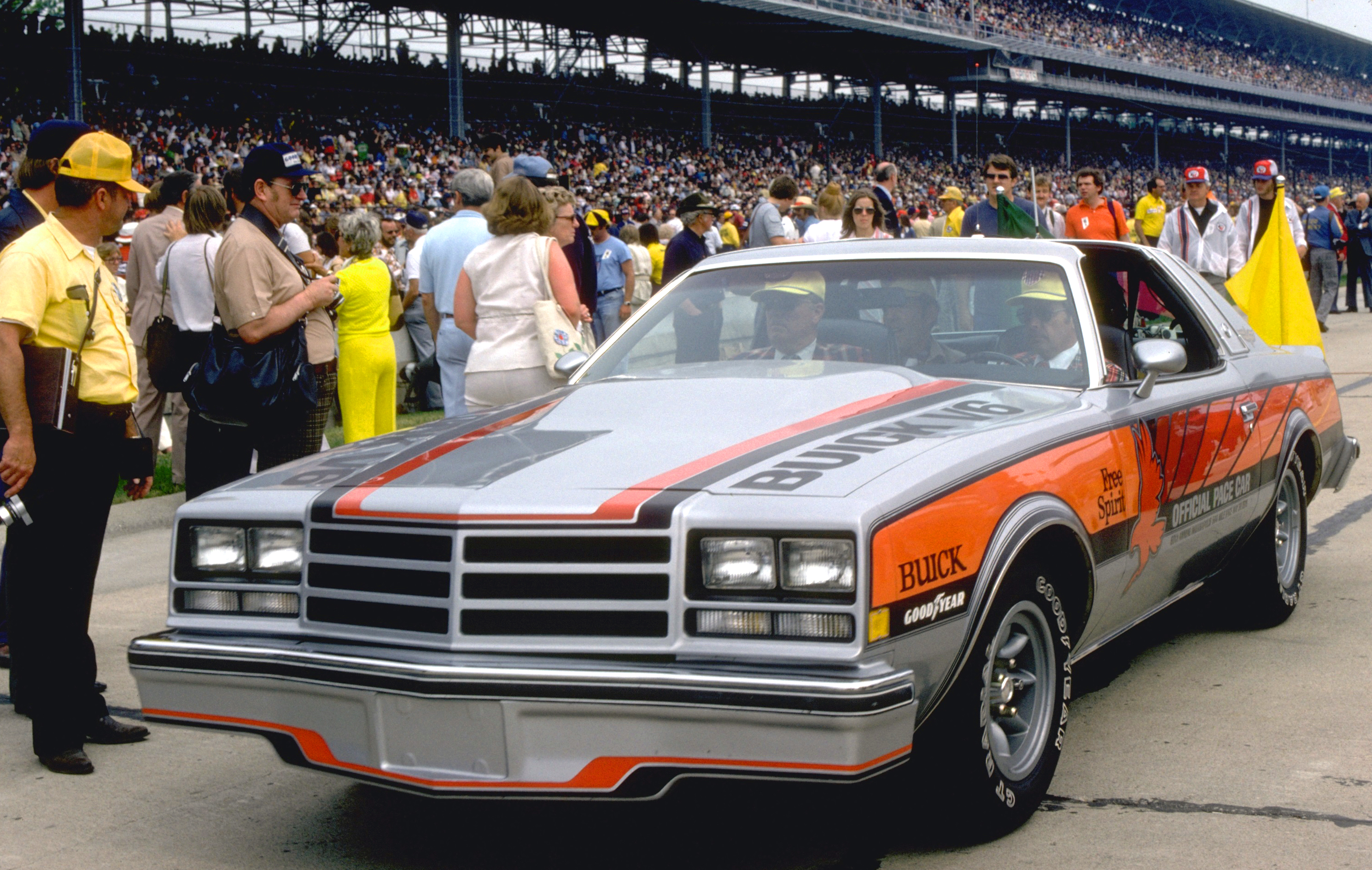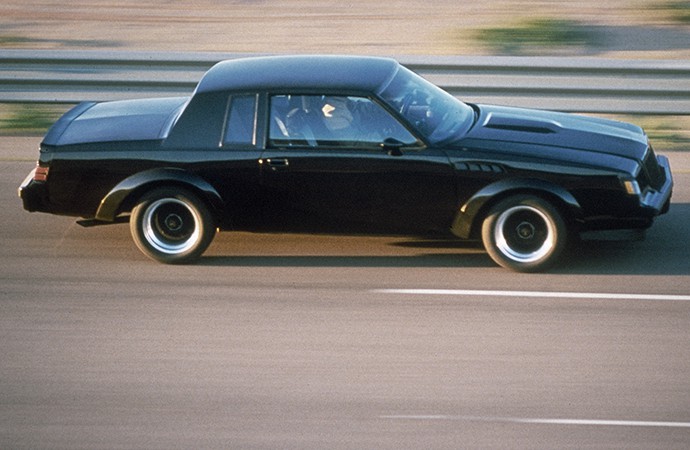Editor’s note: This is part four of a five-part series looking at the history and future of the muscle car. Read the whole series during July, when the ClassicCars.com Journal celebrates all things muscle.
The heyday of the Detroit muscle car era certainly was fun while it lasted. But with high insurance premiums, government safety and emission regulations, and the first of the petroleum shortages cut the party short.
Instead of muscle cars, we were left with the likes of Chevrolet Corvettes with only 165 horsepower, feeble Fords (think Mustang II) and Chrysler K cars.
While Buick hadn’t been a major player in the heyday of Detroit muscle cars, but a few years later, it would lead something of a muscular renaissance, albeit one based on six, not eight, cylinders.
Buick provided the pace car for the Indianapolis 500 in 1975 and again in 1976. In 1975, the Buick Century that led the 33-car field around the Indianapolis Motor Speedway carried a 455cid V8 under its hood. But in the bicentennial year, a turbocharged V6 provided the pace car’s power.

The 1975 model year also was when Buick became the first Detroit automaker to put a now-ubiquitous V6 into its passenger-car fleet. The 231cid engine was lighter than the previous inline-6 or the larger V8, and was rated at 105 horsepower with a substantial 185 pound-feet of torque.
By 1978, Buick would introduce a turbocharged V6 engine into its passenger-car fleet, providing as much as 165 horsepower to its Regal and LeSabre coupes.
After normally aspirated and V8-powered Regals won the NASCAR stock car championship in 1981 and 1982, Buick was eager to capitalize on the success, so a very limited run of special turbocharged Regals was dubbed the Grand National, taking the name of NASCAR’s top series.
The Grand National returned — and in a big way — for the 1984 model year. The cars were painted all black, and their engines provided 200 horsepower and 300 pound-feet of torque. But the big news was still to come. By the car’s final year of production in 1987, it had emerged as the GNX, the X short for Experimental. Produced in conjunction with McLaren Performance Technologies and ASC, the GNX could provide as much 300 horsepower and 420 pound-feet of torque.
Not only was this a new sort of Detroit muscle car, benefiting in part from the Star Wars movie and a Car and Driver headline, “Lord Vader, your car is ready,” but Buick Grand Nationals and GNXs have become favorites with car collectors.

Buick also would do turbocharged V6 engines for Indy car racers, setting speed records and even winning the pole position for the 500-mile race at Indianapolis.
Chevrolet had its own a flirtation with muscle cars in this era, offering a new and full-size Impala SS for 1994, 1995 and 1996, although the 500cid V8 used in the concept-car version was replaced in production guise by a small-block V8.
Interestingly enough, other than the Buick Grand National, the most muscle car-like vehicles of this era were trucks.
For 1991 (and with a handful for 1992, and primarily for export sales), GMC produced a high-performance version of its compact Sonoma pickup truck. Dubbed the GMC Syclone, the truck had all-wheel drive, 4-wheel anti-lock brakes and a turbocharged 280-horsepower V6 engine with 350 pound-feet of torque, and could compete favorably with Chevrolet Corvette in standing-start acceleration.

For 1992 and 1993, GMC put that engine into its compact sport utility vehicle, the Jimmy, to transform it into the Typhoon.
Again, however, it was only fun while it lasted, and another era of Detroit muscle ended so quickly that many people likely didn’t even notice.
Read the other parts of the series:
- • Part I: The road to the muscle car was paved after World War II
- • Part II: Better late than never: How Chevrolet changed V8 engines
- • Part III: How the Pontiac GTO initiated the heyday of muscle cars in America
- • Part IV: Buick led a short-lived muscle car renaissance in the ’70s and ’80s
- • Part V: Will the muscle car go extinct or flourish in a changing world?






80,s & 90,s turbo Mopars. Cheaper, better handling, many more of them built. Buicks were bankers cars, blue collar bought cheap, fun to drive cars all day long. Yeah, FWD sucks. But if that RARE GNX or T TYPE is caught sleeping… those turbo twinkies could be a formidable foe. They gave 5.0 ‘Stangs & Camaros fits if you could get traction. No, I don’t believe they lead the way, but they sure stood out and had a lot of respect when you SAW one.
Bankers cars? I was a 26 year old truck driver with a wife who was a stay at home mom, and two little kids in ‘88. Our family car, and her daily driver was a black ‘87 Turbo T. I bought that car from a guy about my age who lived in an apartment. We sold a nice ‘84 Monte Carlo SS to buy it. The Turbo Regals were slightly more expensive than the Monte Carlo and Olds 442, but they were twice the car and did EVERYTHING better. I never lost a stoplight race with that Buick. Corvette, IROC Camaro, GTA Firebird, Mustang GT, or a Turbo Chrysler. Yeah, the Turbo Chrysler’s were pretty quick. And they were, and still are, cheap.
And regarding the GNX. I have only seen one GNX cruising the streets since they were built in 1987. Most people seem to refer to any turbo Regal as a GNX these days, when in reality it was as rare to see one of the 547 built anywhere back then, just as it is today. Thanks to the Fast and Furious movies, most people don’t seem to know what a real GNX is
A couple of things: first, the Buick pace car shown may have been the first production-based crank-triggered ignition car from Detroit. I remember staring at it in the pits at Indy wondering where the distributor was until a Buick engineer hipped me.
Secondly, some of the other turbo Buicks were pretty good rides as well.
Not so much their attempt to "diesel-ize" V engines.
Third, the Buick Turbo Indy motors were the great lost hope at Indianapolis. For years we went hoping to see a turbo stock block really run with the "race engine" group. Wouldn’t you know that in the year we thought e had our best chance, Roberto spun the damn car into the infield on the pace lap?
I wonder why GM ended up bankrupt? Caddie’s with a north star engine, Buicks with hopped up motors, stopping production of Olds and especially the Cutlass, which in 1979 sold like a million by them selves, Pontiac competing with every other GM division for sales, when they were known for performing, doing away with names like Impala, Malibu, etc. Great leader ship by non car guys!!!
It wasn’t just the Buick’s… There was the Camaro/Firebird Trans Am. Then the G-Body cars
The Chevy Impala SS, Pontiac Grand Prix, The Hurst/Olds and 442’s/Cutlass…. Oh, did I mention the number 1 selling car in the 1980’s (81-88) was the Olds Cutlass G-body cars… Cutlass, Cutlass Supreme,Cutlass Salon, Cutlass Calais and in which the ’83 and ’84 Hurst Olds package came from and then the 442 from’85 on… So don’t say Buick was the only one with the GNX, and T type Regals